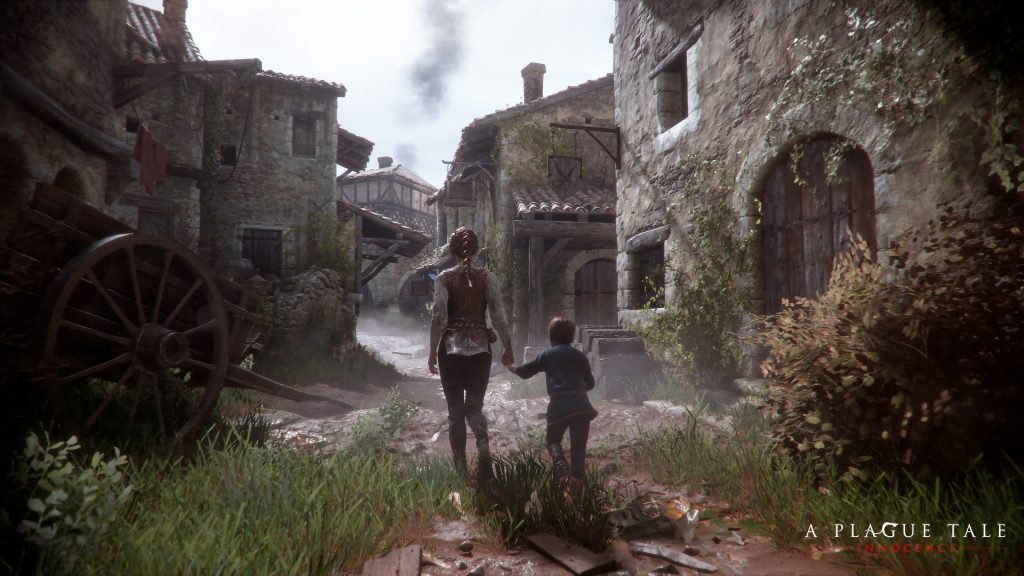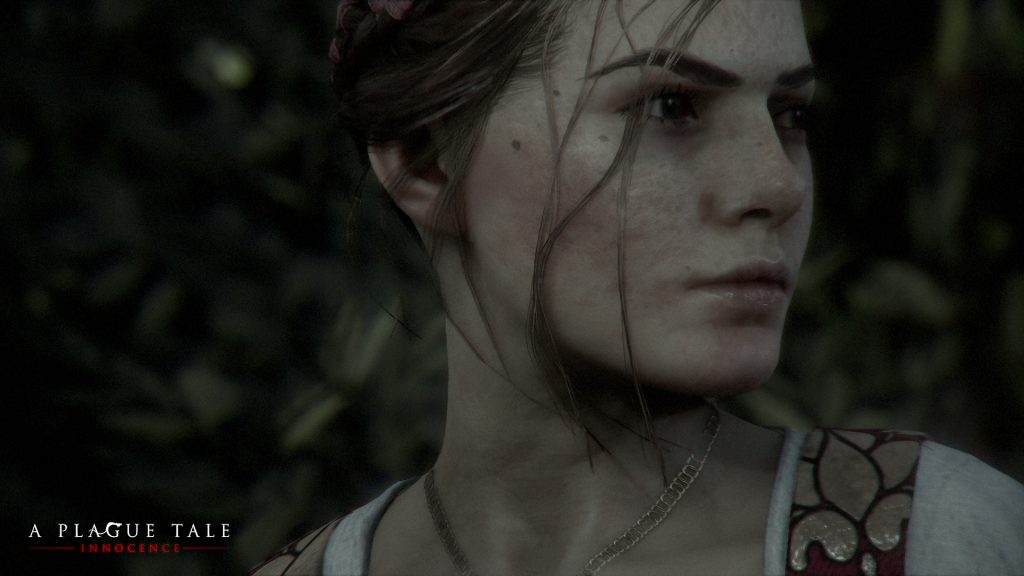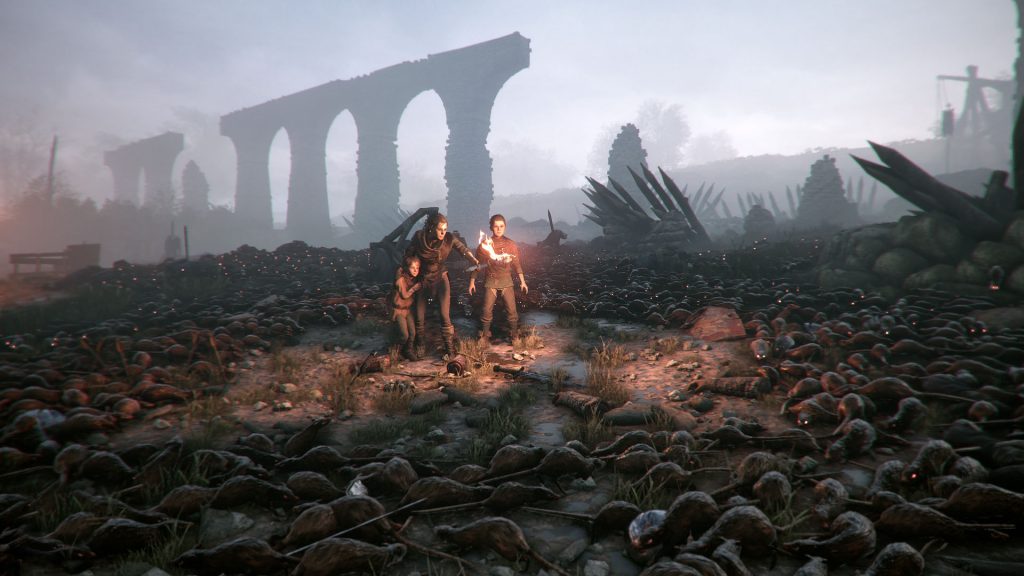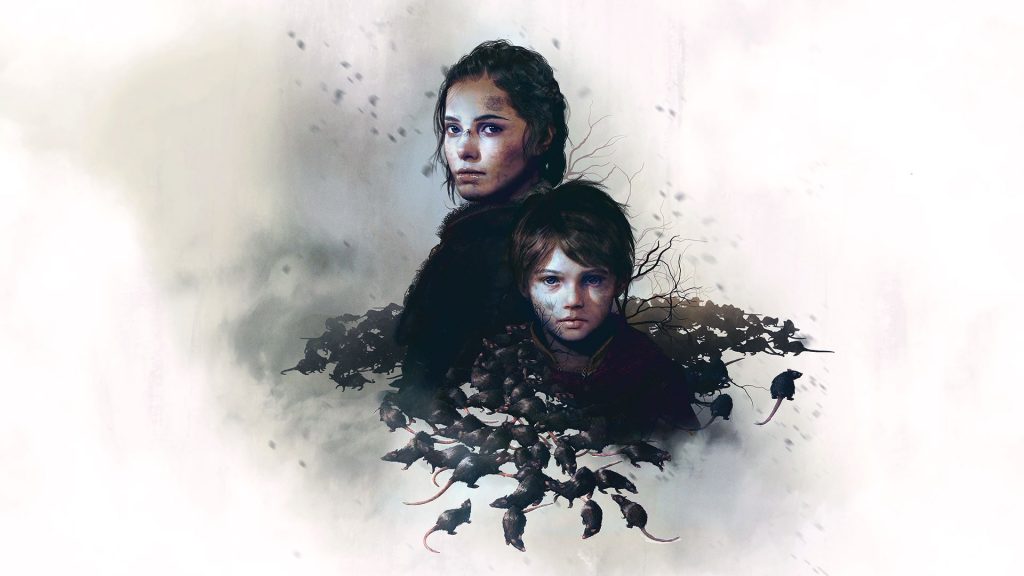Every now and then an indie game comes long that manages to out-Triple A a lot of Triple A studios. These games may have some bugs and janky animations, but more often than not they triumph despite their rough edges. A Plague Tale: Innocence is exactly this sort of game, developed by Asobo Studios (ReCore, Zoo Tycoon: Ultimate Animal Collection), it presents a beautifully-realised world in plague-ridden France during the Hundred Year’s War, and tells an engaging story about family, trust and institutional corruption all within a framework of consistently interesting stealth gameplay.
You play as Amicia, a teenage girl of noble birth, who is on the run from an evil order of knights and alchemists. Her five-year-old brother Hugo, who her parents had kept from her due to a mysterious illness, is now solely under her care, and together they must travel the land in search of safety and answers.
 It’s a simple enough premise but what really works here is the relationship between Amicia and Hugo, estranged siblings who must quickly learn to cooperate with and trust each other. Thanks to the solid script and voice acting this core relationship feels natural right away. The performances are extra impressive considering that, for a significant portion of the cast, it’s their first voice acting role. It wasn’t long before I was totally invested in the sibling’s relationship, and their story of survival.
It’s a simple enough premise but what really works here is the relationship between Amicia and Hugo, estranged siblings who must quickly learn to cooperate with and trust each other. Thanks to the solid script and voice acting this core relationship feels natural right away. The performances are extra impressive considering that, for a significant portion of the cast, it’s their first voice acting role. It wasn’t long before I was totally invested in the sibling’s relationship, and their story of survival.
A Plague Tale is a third-person stealth game, reminiscent of The Last of Us, at a basic level. The puzzles revolve around traversing a dangerous environment, there are collectible items to find, and there’s a heavy emphasis on visual storytelling, with characters discussing their surroundings as you move through the level. Amicia wields a sling which she can use to fire rocks and a variety of other projectiles she’ll learn to craft throughout the adventure. There are a number of resources to gather which Amicia can use to upgrade her sling and pouches, allowing her to fire more often and carry more items. While the narrative will force you into combat at times, in most cases if an enemy spots you it’s game over.
What makes A Plague Tale really stand out are the rats. Right after Amicia and Hugo flee their family home, these swarms of enormous black rats erupt from underground, devouring everything in their path. The rats fear only light and so a lot of exploring and puzzles revolve around finding a safe, well-lit path to get through the hordes unscathed. In one sequence, as I was trying to sneak through a village undetected, I came across a peasant who had hung themselves in their house. With a quick shot from Amicia’s sling, the corpse dropped to the floor and became the rats next meal, distracting them long enough for me to get past. These rats are an ever-present threat throughout A Plague Tale, and they’re utilised in creative ways that impact both the story and gameplay. Hugo is horrified, for example, when Amicia destroys a soldier’s lantern with her sling, allowing the rats to rush in and devour him on the spot, guaranteeing their safety. What would normally be a rote stealth sequence here becomes a game of “which soldiers do I kill, and which do I let the rats kill for me?” all while avoiding being eaten alive yourself.
These rats are an ever-present threat throughout A Plague Tale, and they’re utilised in creative ways that impact both the story and gameplay. Hugo is horrified, for example, when Amicia destroys a soldier’s lantern with her sling, allowing the rats to rush in and devour him on the spot, guaranteeing their safety. What would normally be a rote stealth sequence here becomes a game of “which soldiers do I kill, and which do I let the rats kill for me?” all while avoiding being eaten alive yourself.
The pace at which this game throws new tools and ideas at you is near perfect. Just when you start to get sick of a particular kind of puzzle you’ll be introduced to an entirely new mechanic. Lucas, an alchemist’s apprentice who joins you on your quest early on, provides you with a new concoction to fire from your sling which are always a blast to muck around with. Peppered throughout are just enough things to keep the game feeling fresh for all sixteen chapters, and very rarely does any one element overstay its welcome.
The environments are linear, but gorgeous. From shuttered farming villages, to misty woods with roman ruins, from a battlefield strewn with a seemingly impossible amount of corpses, to an immense, rat-infested cathedral, each new chapter of A Plague Tale brings with it an exciting promise of yet another lovingly rendered and historically-inspired place to explore. The character and facial animations are about what you’d expect from an indie game of this caliber, a little stiff at times but they always impressed when it really mattered. Visual fidelity is often one of the first compromises an ambitious indie game is forced to make, but this is not the case with A Plague Tale. The music is another standout aspect due in part to its efficiency. The score is almost entirely strings, but they’re utilised in such diverse ways that this limitation is truly disguised. Rhythmic, dread-inducing bursts are the backdrop of many scenes of increasing unease, and then when all hell breaks loose and Amicia and company are just barely outrunning the rats, the strings explode into chaotic, hair-raising noise.
The music is another standout aspect due in part to its efficiency. The score is almost entirely strings, but they’re utilised in such diverse ways that this limitation is truly disguised. Rhythmic, dread-inducing bursts are the backdrop of many scenes of increasing unease, and then when all hell breaks loose and Amicia and company are just barely outrunning the rats, the strings explode into chaotic, hair-raising noise.
A Plague Tale: Innocence is a game that capitalises fully on its scope, never settling for simplicity nor trying to reach beyond its grasp. It has a clear idea of what it wants to achieve and Asobo Studies has successfully brought those ideas to fruition. It may tell a somewhat familiar tale of good and evil, of corruption and innocence, but the core relationship between Amicia and Hugo is strong enough to support it. Similarly, the stealth gameplay and environmental puzzles are by no means groundbreaking, but they’re presented in such a way that it feels new and exciting. A Plague Tale: Innocence is bold first step towards greatness from a relatively unknown studio and I can’t wait to see what they accomplish next.
Rating: 8/10
A Plague Tale: Innocence was reviewed on PS4 with a code provided by Five Star Games.

